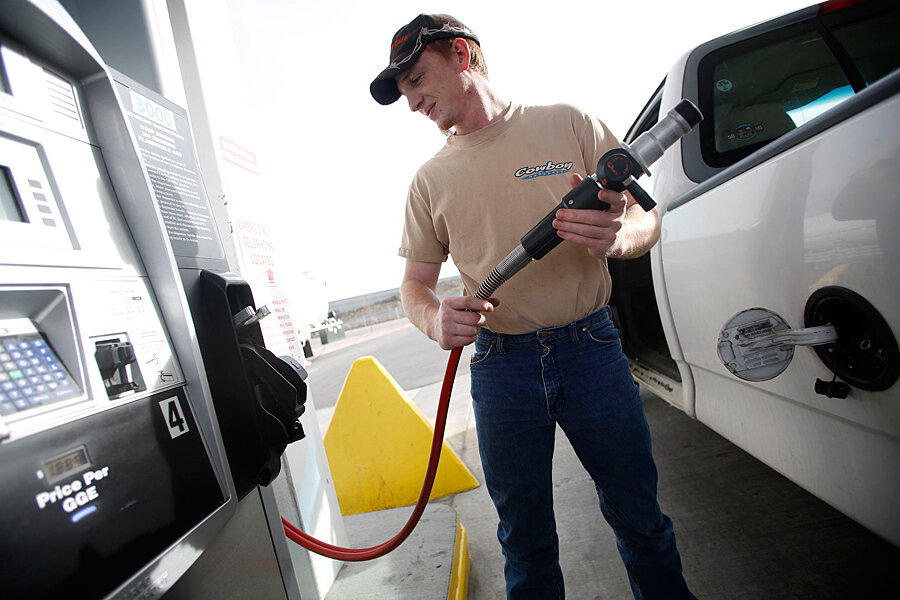Lab results raise question: Do we need oil if we have natural gas?
Loading...
Researchers say they have uncovered a way to convert key compounds in natural gas to alcohols for use in industry and transportation far more cheaply than current approaches, raising the possibility that gas could unseat petroleum as the primary source for fuel or chemicals used to produce materials such as plastics.
The results so far represent a proof of principle, cautions Roy Periana, a chemist at the Scripps Research Institute in Jupiter, Fla, who leads the team working on the approach. Additional science questions must be answered and some basic development work done to set up a workbench-scale prototype that engineers could evaluate for commercial potential.
But the science hurdles remaining are much lower than the one the team had to clear to demonstrate its approach, Dr. Periana says.
"This is a scientific breakthrough," says Daniel Resasco, a University of Oklahoma chemical engineering professor, who was not a member of the research team. However, he, too, cautions that much more work needs to be done to see if the approach the team used is commercially viable.
If it is viable, it could have a profound effect on boosting the value of natural gas, which the United States is producing in prodigious amounts since the advent of hydraulic fracturing, which uses high-pressure fluids to shatter gas-bearing rock formations and release gas that otherwise might be unrecoverable.
Already, the low price of gas has stimulated a shift from oil to gas for petrochemicals, says Eric Potter, program director for energy research at the Texas state Bureau of Economic Geology at the University of Texas at Austin.
"One of the impacts of having a low price and big supply is that suddenly the petrochemical industry is saying: Whoa! Maybe we ought to stop going to the refinery gates and go to the natural gas processing gates for what we need," he says.
At the same time, he adds, expanded drilling in other proven shale-gas "plays" is on hold because the price of gas is so low. One such area is the Haynesville shale formation that underlies southwestern Arkansas, northeastern Texas, and northwestern Louisiana.
"There is a lot of capacity that can be brought into production if the price goes up," Mr. Potter says. "If something like this adds value to natural gas, the price would go up – up to a certain point."
Any increases would affect the relative advantage that oil and gas would have as feedstock for chemicals and fuels, he adds.
For now, however, the main focus is on the science and what remains to be done to test the commercial viability of the approach Periana's team has uncovered.
The challenge is about breaking bonds – carbon-hydrogen bonds. Carbon and hydrogen make up methane and other hydrocarbons found in natural gas. These additional hydrocarbons include ethane, propane, and butane, among others.
The carbon-hydrogen bonds are quite strong. This strength accounts for natural gas's long-term stability in underground reservoirs; it doesn't react with its surroundings. But that strength also requires a lot of energy to overcome it when trying to convert these hydrocarbons, known as alkanes, into their corresponding forms of alcohol.
Current techniques for producing these occur at temperatures as high as 900 degrees C (1,652 degrees F.). Indeed, since the 1930s and ’40s, high-temperature processes have been used to turn the components of natural gas into an intermediate form of gas known as syngas. Syngas is then used to make methanol or diesel fuel, Periana explains.
But this is a complex, multistep process that takes place in commercial plants costing billions of dollars, he continues. "The capital costs contribute 70 percent of the overall cost of a product" from the facilities, he says.
In principle, if facilities could convert alkanes at low temperatures, even at room temperature, and especially if the processing could occur in one step, the capital costs for exploiting the widest possible uses for natural gas would plummet.
Until now, he says, "no science existed to do that."
Periana, who has been working on the low-temperature conversion of natural gas for 25 years, initially explored the use of expensive, exotic metals as catalysts. This approach required the use of powerful, concentrated acids to convert the alkanes to chemicals and fuels once the catalysts had done their work in lowering the energy needed to break the carbon-hydrogen bonds. This splitting of carbon from hydrogen took place at 180 degrees C, but the work wasn't commercially viable, he says. Among other things, the approach didn't work well at converting the higher-value alkanes in gas – ethane and propane. And it would have been difficult to use the intense acids in a commercial setting.
In a paper published Friday in the journal Science, Periana and his colleagues describe their new approach to converting methane, ethane, and propane in natural gas at a temperature of 180 degrees C. They use less expensive, relatively more abundant metals such as lead and thallium as catalysts, and substantially weaker acids. They found that the approach works well at converting all the alkanes of interest into an alcohol/acid solvent from which methanol, ethanol, ethylene glycol, and other alcohols would be purified.
Although the results represent a significant breakthrough, Dr. Resasco of the University of Oklahoma says he's interested in seeing a second piece of the process fall into place. Periana and colleagues have demonstrated an ability to convert the alkanes, he says. But team also needs to regenerate the catalysts to show a complete "catalytic cycle."
The team has demonstrated the first part of the cycle, he says, adding, "We're keeping our eyes open to see the other shoe fall."







